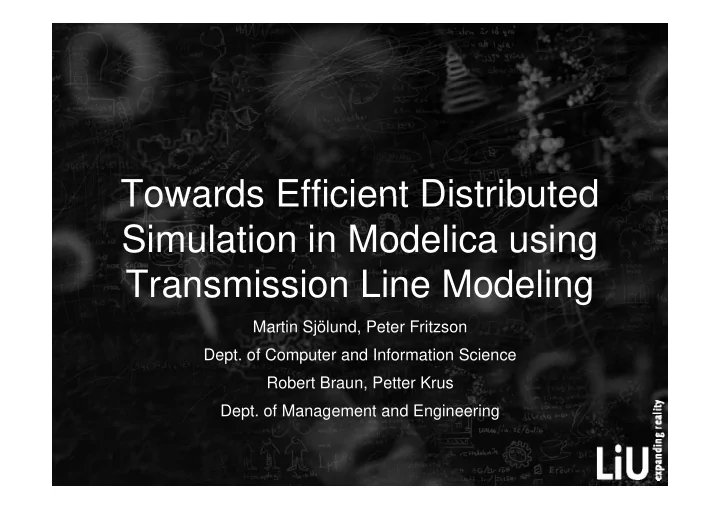

Towards Efficient Distributed Towards Efficient Distributed Simulation in Modelica using Transmission Line Modeling Martin Sjölund, Peter Fritzson Dept. of Computer and Information Science Robert Braun, Petter Krus Dept. of Management and Engineering
Simulations are slow Simulations are slow Centralized solvers are hard to parallelize Large systems do not scale well Stability depends on a global step size 2
Modern computation units Modern computation units Multi-Core is the standard Parallelism even for home users Throughput incr. 55%/year Assumed increase Assumed increase Penalizes single-threaded P li i l th d d 17%/year possible applications Device speed Limit: Clock rate Stuck with CPU Stuck with CPU performance from 2004 Pipelining Limit: RISC ILP RISC/CISC CPI RISC/CISC CPI 2006 Source: Doug Burger, UT Austin 2005 90 nm 65 nm45 nm 32nm 22nm 3
Problems and Solutions Problems and Solutions Problem 1: Speeding up group of simulations Parallel parameter sweep with one simulation per core Problem 2: Speeding up single simulation for short real-time deadlines deadlines Simplifying the model Parallelizing single simulation Parallelizing single simulation 4
Distributed model Distributed model SubSystem 3 Solver: Euler Stepsize:0.001 SubSystem 4 Solver: LAPACK Stepsize:1.0 S i 1 0 SubSystem 1 SubSystem 2 Solver: Dassl Solver: Lsode2 Stepsize:0.1 p Stepsize:0 01 Stepsize:0.01 5
6 Partitioning the model Partitioning the model
Changing the model Changing the model Changing the connections? Find a better model Retain physically accuracy 7
Transmission Line Modeling g TLM – Transmission Line Modeling – numerically stable co-simulation Physically motivated delays are inserted into TLM element models Physically motivated delays are inserted into TLM element models Originally used in hydraulics with propagation delays along pipes Generalized to other engineering domains c1, c2 are the TLM-parameters Ttlm is the information propagation time Ttl i th i f ti ti ti Zf is the implicit impedance c2 v1,i1 v2,i2 c1 c1 8
HOPSAN HOPSAN TLM-specific simulation software Efficient simulations Easy to connect components Hard to create new components Written in C++ or Fortran Hard to read old code Explicit discretization 9
Does TLM work in Modelica? Does TLM work in Modelica? The discretization is done by the compiler and/or solver There are multiple solvers to choose from Equation-based models are easy to read and maintain 10
Decoupling subsystems using delay()? Decoupling subsystems using delay()? Breaks dependencies between components Interpolation and performance problems Initialization cannot be decoupled During initialization, the delay is the actual expression without delay in Modelica delay in Modelica 11
Prototype model Prototype model Pressure relief valve 3x2 variations of the model TLM delay-lines between subsystems using delay(), sample(), or der() Spring modeled using der() or explicit euler Spring modeled using der() or explicit euler using the delay() operator R Real v = (x-delay(x,T))/T; l ( d l ( T))/T // v = der(x) Real a = (v-delay(v,T))/T; // a = der(v) 12
13
der() sample() delay() HOPSAN HOPSAN HOPSAN, a=0 Spring using delay() Spring using der() 14
Future Future Support manual partitioning of models in OpenModelica Integrate these methods in the new OpenModelica parallel b backend k d Integrate HOPSAN and OpenModelica models 15
www.liu.se
Recommend
More recommend